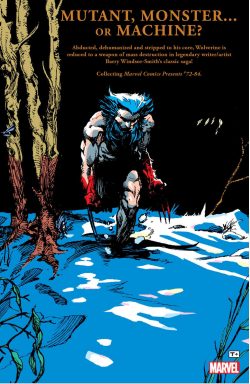

By Jamie Delano, Rick Veitch, John Ridgway, Alfredo Alcala, Tom Mandrake, Brett Ewins, Jim McCarthy & various (DC Comics)
ISBN: 978-1-4012-3006-7 (TPB/Digital edition)
Originally created by Alan Moore during his groundbreaking run on Swamp Thing, mercurial modern wizard John Constantine is a dissolute chancer who plays with magic like an addict but on his own terms for his own ends. He is not a hero. He is not a nice person. Sometimes though, he’s all there is between us and the void…
Given his own series by popular demand, Constantine premiered at the height of Thatcherite Barbarism in Britain, during the dying days of Reaganite Atrocity in the US, to become a founding father of DC’s adult-oriented Vertigo imprint. Hard to imagine back then that we’d one day be looking back with any sense of fond nostalgia, but there you go…
This collection collects John Constantine, Hellblazer #1-9 plus crossover chapters from Swamp Thing #76-77; cumulatively spanning January – October 1988 at what was the beginning of a renaissance in comic book horror that continues to this day.
Back in 1987 Creative Arts and Liberal Sentiments were dirty words in many quarters and the readership of Vertigo was pretty easy to profile. British scripter Jamie Delano began the series with a relatively safe horror-comic plot about an escaped hunger demon, introducing us to Constantine’s unpleasant nature and odd acquaintances – such as Papa Midnite – in a tale of infernal possession and modern voodoo, but even then, discriminating fans were aware of a welcome anti-establishment political line and metaphorical underpinnings.
‘Hunger’ and ‘A Feast of Friends’ also established another vital fact. Anyone who got too close to John Constantine tended to end very badly, very quickly…
‘Going for It’ successfully equated Conservative Britain with Hell (no change there either, obviously), with demons trading souls on their own stock market and Yuppies getting ahead in the rat race by selling short. Set on Election Day 1987, this potent pastiche never loses sight of its goal to entertain, whilst making telling points about humanity, individuality and society.
Constantine’s cousin Gemma and tantalising splinters of his Liverpool childhood are revealed in ‘Waiting for the Man’: a tale of abduction and ghosts introducing disturbing Christian fundamentalists The Resurrection Crusade, and a mysterious woman known only as Zed.
America is once again the focus of terror in ‘When Johnny Comes Marching Home’ as the Vietnam war breaks out again in rural Iowa, before we pop back to Blighty for ‘Extreme Prejudice’.
Skinheads, racism demons and more abound as Delano cannily joins up lots of previously unconnected dots to reveal a giant storyline in the making. The Damnation Army are up to something, but nobody knows who they are. Now everything’s going bad and somehow Zed and the Resurrection Crusade are at the heart of it all…

Brett Ewins & Jim McCarthy briefly replaced magnificent regular illustrator John Ridgway for the first 3 pages of ‘Ghost in the Machine’, before the beautifully restrained, poignantly humanistic stylism returns with Constantine further unravelling the Damnation plot by catching up with the Coming Thing: the cutting edge mysticism dubbed cyber-shamanism.
In Delano’s world the edges between science and magic aren’t blurred – they simply don’t exist…
Alfredo Alcala signs on as inker with ‘Intensive Care’ and the drama ramps up to a full gallop as the plans of both Crusade and Army are revealed, with the value and purpose of Zed finally exposed. All Constantine can do in response is make the first of many bad bargains with Hell…
We then take a stranger turn due to the nature of periodical publishing. The storyline in Hellblazer #1-8 ran contiguously, before converging with Swamp Thing wherein the wizard reluctantly lends his physical body to the planetary plant elemental so that the monster can impregnate its human girlfriend Abigail Arcane. Thus, in the ninth issue, there’s a kind of dissolute holding pattern in play as the weary wizard confronts ghosts of all the people he’s gotten killed to allow all the pieces to be suitably arranged. ‘Shot to Hell’ (Delano, Ridgway & Alcala) then neatly segues into Swamp Thing #76-77 for the conception of a new messiah. Sort of.
Immediately post-Alan Moore, Swamp Thing comics were sidelined by many fans. However they soon realised successor (writer-artist) Rick Veitch – aided by moody inker Alcala – was producing a stunning sequence of mini-classics well worthy of serious scrutiny. The issues built on Moore’s cerebral, visceral writing as the world’s plant elemental became increasingly involved with ecological matters.
Having decided to “retire”, Swamp Thing (an anthropomorphic plant imprinted with the personality and mind of murdered biologist Alec Holland) was charged by his ephemeral overlords in “The Green” with facilitating the creation of his/its successor. However, the ancient and agonising process was contaminated by consecutive failures and false starts, leading to a horrendous series of abortive creatures and a potentially catastrophic Synchronicity Maelstrom.
Alec, “wife” Abigail and chillingly charismatic Constantine are eventually compelled to combine forces – and some body-fluids – in ‘L’Adoration de la Terre’ (ST #76, by Veitch & Alcala) – to conceive a solution before the resultant chaos-storm destroys the Earth.
The process is not with risk – or embarrassment – but the affair is brought to a successful conclusion in ‘Infernal Tringles’ (Swamp Thing #77, Tom Mandrake pencilling) and with terrestrial order restored, the participants go their separate ways… but events have affected them all in ways that will have terrible repercussions in months and years to come…
Rounding out this so-sophisticated spook-fest is an original covers gallery by Dave McKean and John Totleben, plus an in-world exposé of Constantine in ‘Faces on the Street’ by faux journalist Satchmo Hawkins. Also included are other relics of the antihero’s sordid past such as the lyrics from Venus of the hardsell – a single from John’s aberrant punk band mucous membrane – and extracts from the magician’s medical file whilst he was held in Ravenscar Secure Psychiatric Facility…
Delivered by creators capable and satiric, but still wedded to the basic tenets of their craft, these superb examples of horror fiction – inextricably linking politics, religion, human nature and sheer bloody-mindedness as the root cause of all ills – are still powerfully engaging. Lovingly constructed, they make a truly abominable character seem an admirable force for our survival. The art is clear, understated and subtly subversive while the slyly witty, innovative stories jangle at the subconscious with scratchy edginess.
This is a book no fear-fan should be without.
© 1987, 1988, 2011 DC Comics. All Rights Reserved.



















